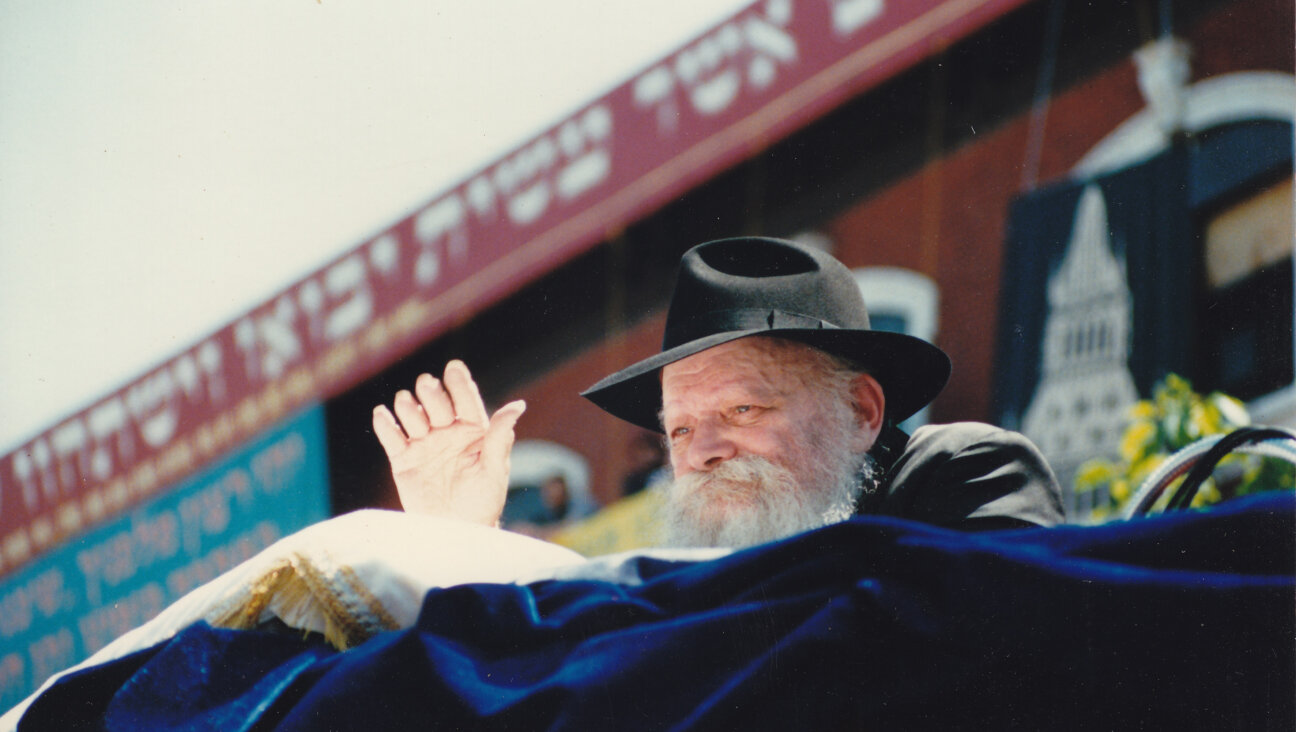Through a Nazi Lens

Actor Extraordinaire: Gregory Peck Image by Karen Leon
Lights! Camera! Death! “A Film Unfinished”: The Warsaw Ghetto Through a Nazi Lens
When I was invited in June by Poland’s Ministry of Foreign Affairs to participate in a conference titled “Public Diplomacy and Polish-Jewish Relations,” to be held in Warsaw in October, I had mixed emotions. Yes! What a wonderful opportunity to revisit the city my mother and I fled a few months before the ghetto walls went up. Still, I have been reluctant to return to the “new” Warsaw, because, as I often tell people: “In my mind, I can still walk the streets of prewar Warsaw… revisit its prewar sights, smells and texture; my kindergarten on Nowolipki Street, across from the Folkszeitung newspaper where my father worked; our sixth-floor walk-up apartment on Leszno 6, and our last prewar residence on Swieto-Jierska, where our partially bombed building would later face the ghetto wall and where, following the 1943 Warsaw Ghetto Uprising, within its demolished bunkers, two of the 14 milk cans of documents and diaries buried by Emanuel Ringelblum were found.

Actor Extraordinaire: Gregory Peck Image by Karen Leon
On July 8 I saw Yael Hersonski’s astonishing Sundance Film Festival winning documentary, “A Film Unfinished,” which showed never-before-seen footage of the ghetto. Filmed by the Germans and intended as part of a propaganda tool, the decision was made for me. I could not go back — yet. Not only Leszno, but also Karmelicka, Gesia, Smocza — streets I had walked and shopped on, that became the heart of the ghetto — exist only on film or in memory. Like one of the women in the documentary who “kept looking for my mother” among the faces of the ghetto inmates, I, too, kept replaying the film, hoping to catch a glimpse of my mother’s sisters — Cyvia (who gave birth to a healthy baby girl named Sarah in the ghetto) and Shifrah (who either perished in the ghetto or was sent to Treblinka).
On July 10 I connected with Hersonski in Israel. “I wish I had known you had been in Warsaw then” she told me. Why did she make the film? And why so oblique a title — no reference to Warsaw or ghetto, which would have been a “flag” for survivors and others for whom this film would have special resonance? “It’s not only about the Warsaw Ghetto, but a film about the incapability to see and feel and understand what we see in images in our history,” was the archivist’s explanation. “The reality of any place is endless, the complexity so immense… the images… captured moments of what really happened [was my] challenge to release these fragments of time to capture… to experience reality beyond planned script… as a document more complex than written… nonlinear.” Hersonski was referring to the never-before-seen reel of film she includes in the documentary, which contains the now de rigueur Holocaust excerpts used in Holocaust-related films and documentaries, which turned out to have been staged and filmed by a German crew.
“My challenge was to enable the Israeli viewer — who has been brainwashed by the educational system — to remember better…There are ceremonies, but we don’t understand…we don’t remember…we are not emotionally attached to what we see, the inconceivable suffering of the ‘other’…I did not go to memorial museum[s] or the young delegations to [the concentration camps of] Poland,” Hersonski told me, referring to “The March of the Living” — a rite of passage for many young people.
Nowhere in the documentary is there an indication that the half million Jews crammed into the three square miles of the ghetto had identities beyond “rich Jews and poor Jews.” This may have been the German filmmakers’ intent. But for viewers unfamiliar with prewar Warsaw — or any of the communities from which Jews were shipped to the Warsaw Ghetto — the ragged, often near-dead survivors had at one time been doctors, teachers, lawyers, seamstresses, musicians, merchants and craftsmen. In “Schindler’s List,” even among the nameless victims at the Plaszow concentration camp, Steven Spielberg offers two telling vignettes: A Nazi asks Oskar Schindler (Liam Neeson) where he got the handmade shirt he’s wearing, to which Schindler replies: “The craftsman who made it is probably dead.” And when a young woman alerts a Nazi official that the barracks that the inmates are building is not up to code, she identifies herself as a graduate of an architecture school in Milano, Italy. “Ah! An educated Jew!” comments the Nazi, and then has her shot on the spot.
“My grandmother was born in Lodz,” Hersonski continued. “My grandfather worked for [the agency Film Polski on documentaries…He was a producer, director, film editor, made films about coal mines, churches. In 1957, my grandmother experienced hostility because she was a Jew…My parents could not care less about Zionism; they just wanted to leave…My grandfather fought in the Polish army with General Anders at Monte Casino…. My grandmother, a daughter of a famous architect in Warsaw, lived in the ghetto until January 1943. They had money. They were assimilated. They survived by buying Aryan papers. It was [my personal emotional aspect] that enabled me to work…with the footage.”
The German film footage showed well-dressed people stepping around corpses on the sidewalk. Starving children ignored by seemingly well-fed passersby and waitresses may have been staged. But the starving children, the hunger and death, were a reality. More unsettling was a series of staged Jewish ceremonies: a circumcision of a preemie; the pre-Yom Kippur ritual of kapores, where a man slits the throat of a chicken; a lavish funeral, and — most disturbing — a mikveh scene with men, some of whom were young Hasidim, bathing with zaftig women whose fearful glances at the (unseen) German cameramen are palpable. There is also the oft-shown clip of Germans capturing young smugglers who are forced to empty their rucksacks of turnips, carrots and potatoes onto the ground — then are led off to be shot.
One of the survivors in the film, watching a propaganda clip of a woman with flower in a vase, commented wryly: “Who saw a flower [in the ghetto]? We would have eaten it.” So rare was foliage in the ghetto that in an underground report that appeared in the Forverts, which I read in Montreal in 1942, there was a vignette about a square of grass with a tree in some courtyard in the ghetto. People paid by the minute to sit under the tree! Another Forverts-reported item highlighted in-ghetto entrepreneurship. Seems you could buy bavel, thread, inside the ghetto, which ostensibly was not available in Warsaw proper.
A staged theatrical performance of “Shulmith” — Abraham Goldfadden’s Yiddish operetta — shows an audience forced to sit a full day without food or personal relief and applaud and roar with laughter to the satisfaction of the German camera crew. Onstage were beautiful young women and a magnificent dancer who after the performance may have been sent off to Treblinka. If “Shulamith” does not resonate, it is a landmark of the Yiddish theater, and its lullaby, “Rozhinkes mit Mandlen” (“Raisins and Almonds”), has become a signature soundtrack used in many a Jewish-theme film or documentary.
Hersonki’s documentary is a monumental archival achievement. The revelation that the Germans staged so much of the footage actually highlights the horror of life and death in the Warsaw Ghetto.
The film opens at the Film Forum in New York on August 18 and in Los Angeles on the 20, with nationwide dates to follow.
“To Kill a Mockingbird” and Anti-Semitism — Recalling a Chat With Gregory Peck
The July 11 literary event celebrating the 50 anniversary of Harper Lee’s Pulitzer Prize-winning book, “To Kill a Mockingbird,” reminded me of conversations I had with Gregory Peck, who won an Oscar for his portrayal of Atticus Finch, the Southern lawyer who defends a black man in Macomb, Ala., in the book’s 1962 film adaptation. Peck and his wife, Veronique, were honorees at Broadway producer Marty Richards’s February 11, 1997, “Red Ball,” at The Plaza. During the dinner, when my daughter Karen mentioned that she had read Lee’s book, Peck replied, “I just had lunch with Harper Lee.” Commenting on his role in the Oscar-winning 1947 film adaptation of Laura Z. Hobson’s book “Gentleman’s Agreement,” in which Peck, a Protestant reporter, poses as a Jew and uncovers rampant anti-Semitism, I told Peck that “Ms. Hobson,” whom I interviewed for the Forward in 1983, “said she was very pleased with your portrayal, but was adamant that the book not be perceived as a ‘Jewish’ book, but as an ‘American’ book about Jewish matters.”
At the February 7, 1999, screening of “Forgotten Films To Remember” at the Players Club, at which Peck was the guest of honor, I returned to our earlier “Mockingbird” conversation. Peck mused: “Of the 68 films I have made, my favorite is ‘To Kill a Mockingbird.’ I feel lucky to have to have made that in the ’60s…. I was running out of character roles, and ‘The Boys From Brazil’s Dr. Mengele was one of the most loathsome people I ever portrayed.” When I asked him who his favorite leading lady was, he replied, “Betty Bacall,” who was sitting next to his wife, in front of me. “With all respect to your wife,” Bacall began, “his favorite star was Ava Gardner.” Someone in the audience asked him, “What was the moral watershed of your life?” Pulling himself up to his full height, Peck replied, without hesitation, “Gentleman’s Agreement,” and then introduced one of the film’s main stars, Celeste Holm. Peck told how Daryl F. Zanuck bought the book by Hobson and got a call from Louis B. Mayer: “‘Anti-Semitism is an uncomfortable subject. I want you to forget it.’ A stubborn Zanuck replied, ‘Look, L.B., I’ve got a best-selling book. I’ve got Dorothy McGuire. I’ve got Gregory Peck and Elia Kazan to direct.’ The rest is history.”
Over dessert, I mentioned to Peck that during my 1983 interview with Hobson, when she had published her autobiography, “Laura Z: A Life” (Arbor House, 1983), she publicly disclosed for the first time not only that she was Jewish, but also that the “Z” in her name stood for Zametkin and that her father had been one of the Forverts’ first editors and “was asked to succeed Forward founder Abraham Cahan.” (Her mother wrote a daily advice column in the Yiddish paper Der Tog [The Day].) As we were leaving the club The Players, in Gramercy Park, the now late journalist Sidney Zion said to me, “That’s quite a big switch, going from Ava Gardner to Mengele.” Another guest, composer and Forward subscriber Dorothy Lang, told me that the doctor who had operated on her daughter, Barbara Friedman, at the time a producer at ABC-TV, was Abraham Cahan’s grandson, Anthony Cahan.
A message from our CEO & publisher Rachel Fishman Feddersen

I hope you appreciated this article. Before you go, I’d like to ask you to please support the Forward’s award-winning, nonprofit journalism during this critical time.
We’ve set a goal to raise $260,000 by December 31. That’s an ambitious goal, but one that will give us the resources we need to invest in the high quality news, opinion, analysis and cultural coverage that isn’t available anywhere else.
If you feel inspired to make an impact, now is the time to give something back. Join us as a member at your most generous level.
— Rachel Fishman Feddersen, Publisher and CEO






















